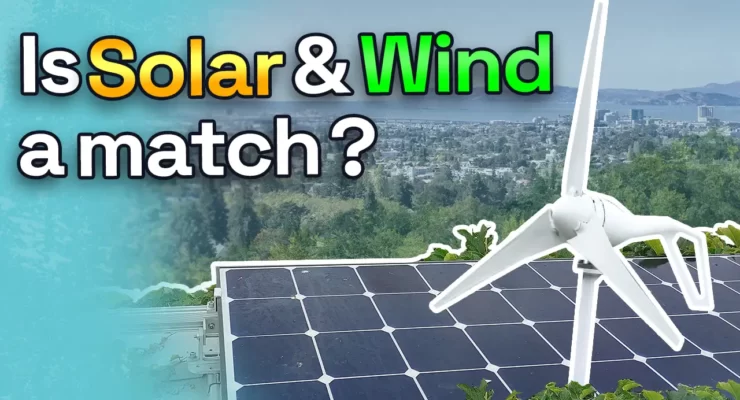
Fast read
In residential areas, small wind turbines are rarely combined with solar panels because of several practical reasons. The problem is that small wind turbines are not efficient in residential areas because of inconsistent and weak winds.
Solar panels, being more suitable for a broader range of sites, can generate electricity even in low-wind conditions. Small wind turbines need a lot of space and can be noisy in strong winds. This makes it hard to use them in cities or suburbs with limited space and strict rules about appearance.
They also demand regular maintenance and have more moving parts, increasing the risk of mechanical breakdowns
As a result, solar panels are a more popular and practical option for residential installations. Large-scale wind turbines are commonly used in expansive wind farms. They can also be cost-effective when paired with solar farms in areas that have high wind levels.
Why are solar and wind power not used together?
In residential areas, wind power is rarely combined with solar panel systems to generate more. In the past, Australian companies sold small wind turbines along with solar PV systems. Some of these companies were Energy Matters, the Solar Shop, and Today Solar.
The turbines were typically 1kW or 1.5kW in size which happened during the solar energy boom.
So why did this practice stop, and why do we not see small wind turbines on residential roofs? Several reasons exist for this.
Efficiency issues
One main issue is energy efficiency. In residential areas, getting a clean flow of wind power is challenging. Wind turbines require a particular minimum of wind power to generate power efficiently.
Many residential and urban settings may lack constant or strong enough winds to make tiny wind turbines economically viable. However, solar panels can generate electricity even in low-wind circumstances and are more suitable for a broader range of sites.
Regulatory environment
Local Council regulations often make it more challenging to install small wind turbines, often because of noise concerns. Obtaining the necessary permits and approvals can be a complex and time-consuming process.
Site suitability
Wind turbines require specific wind conditions to be effective. Not all locations in Australia have the consistent and strong wind power needed to make wind energy viable. This geographical limitation can restrict the potential for including wind turbines in a renewable energy system.
Cost considerations
The installation and maintenance of small wind turbines can be costly. These costs might outweigh the benefits for some customers, especially if the site doesn’t have ideal wind conditions. Conversely, solar panels have become increasingly affordable and offer a more predictable return on investment.
Technical complexity of solar and wind power
Installing and maintaining a wind turbine requires specialised knowledge and skills. Not all solar installers have the necessary expertise to offer this service. Combining solar and wind power can make renewable energy systems more complex, which may discourage some installers from using them.
Consumer demand
Limited consumer interest in or awareness of small wind turbines exists. People know and like solar power more than wind power, especially for small projects.

Aesthetics and noise concerns of solar and wind power
Some people worry about how wind turbines look and sound, especially in cities or suburbs. These concerns affect the willingness of customers to include wind turbines in their energy systems. Even little wind turbines can create noise and alter the surrounding area’s aesthetic.
This can annoy residents as well as the next-door neighbours. Solar panels are frequently chosen for residential installations because they are silent and can be discreet if installed well.
Market focus
Solar installers prefer to specialise in solar PV technology and focus on what they know best. They are often busy already, so adding wind energy is seen as a distraction and unnecessary complication in their business model.
Environmental and birdlife
Some urban residents have concerns about the impact on birds and other wildlife. Properly assessing and mitigating these risks can add to the complexity and cost of the project.
The Archimedes Wind Turbine
In the early 2000s, the small wind turbines on offer were extremely noisy in heavy wind and caused a plethora of Council complaints as soon as they were installed. Sadly, there is no new product in the Australian market to replace the models designed for boating that were removed. So if no appropriate product is available, sales will obviously not eventuate.
There are challenges like practical, technical, regulatory, and market factors that could make it hard to do this in Australia. There is now a new product on the market known as the Archimedes Wind Turbine. This new product has the potential to change the wind and solar power industry forever.
Issues with space
Small wind turbines often can cause a shadow issue towards the nearby solar panels. To collect faster wind speeds, they must be mounted on high towers or masts, which will cast long shadows.
Shadows are the enemy of solar. Solar panels can be easily installed on roofs or small areas. However, it is difficult to find space for wind turbines in cities because of limited space.
Maintenance issues with solar and wind power
Regular maintenance for wind turbines includes lubrication, mechanical component inspections, and periodic assessments for wear and tear. Additionally, they have more moving parts, which can raise the risk of mechanical breakdowns. Solar panels are a good option for homes because they are reliable. They do not have moving parts and need less maintenance than other choices.
So should I combine solar and wind power?
Combining solar and wind power can create a hybrid system renewable energy solution. However, practical factors and limitations often make solar panels the preferred choice for residential and small-scale installations. Large-scale wind turbines are used in expansive wind farms and can complement solar farms in regions with strong wind conditions.
In Australia, an example is the Kidston Renewable Energy Hub that Genex is developing in Far North Queensland.
